A Lithium-ion Battery RUL Prediction Method Considering the Capacity Regeneration Phenomenon
Abstract
1. Introduction
2. Related Algorithms
2.1. Wavelet Decomposition
2.2. NAR Neural Network
3. WDT–NARNN Prediction Method
3.1. Experiment Data Analysis
3.2. WDT- NARNN Modeling Process
| Algorithm 1. The integrated method with WDT and NARNN |
| (1) Initialization: |
| Select the wavelet function and the decomposition levels ; |
| (2) Decomposition: |
| Decompose the capacity series for the levels to obtain the low and high-frequency signals at different scales by Equations (4) and (5); |
| (3) Initialize the NAR neural network: |
| Initialize the parameters of NAR neural network, the numbers of input layer, hidden layer, and output layer are set to , , and respectively, the delay of the network is set to d, and the training function is set to ‘trainbr’; |
| (4) Output the prediction results: |
| Input the decomposed signals into the NAR models to predict the following changes after time T, then prediction results are obtained; |
| (5) Wavelet reconstruction: |
| The signals are reconstructed from 1 to levels by Equation (6) to obtain the fusing predicted series corresponding to capacity series, and then RUL value can be calculated by Equation (8); |
| (6) Evaluate the prediction results: |
| The evaluation is given with original testing data and prediction results through some criteria to evaluate the performance of the integrated method WDT–NARNN. |
3.3. Performance Analysis
- (1)
- Root Mean Square Error (RMSE) to evaluate the prediction accuracy. The smaller the RMSE is, the better the prediction performance:
- (2)
- R2 to evaluate the prediction performance. If the fitting degree between the prediction curve and real curve is high, R2 will be close to 1:
- (3)
- Absolute Error (AE) to evaluate the RUL accuracy of the prediction model:
- (4)
- Prediction Accuracy Improvement Ratio () to evaluate the RUL prediction accuracy improvement ratio of two different methods. If , the first method is more accurate, on the contrary, the second method has higher prediction accuracy:where n is the sample size, is the real value of battery capacity, is the predicted value of battery capacity, and is the mean value of predicted battery capacity. is the real RUL, is the predicted RUL.
4. Results and Discussion
4.1. RUL Prediction of Lithium-Ion Battery
4.2. Different Starting Point Predictions and Comparison
5. Conclusions
Author Contributions
Funding
Conflicts of Interest
References
- Liu, D.T.; Zhou, J.B.; Guo, L.M.; Peng, Y. Survey on lithium-ion battery health assessment and cycle life estimation. Chin. J. Sci. Instrum. 2015, 36, 1–16. [Google Scholar] [CrossRef]
- Lukic, S.M.; Cao, J.; Bansal, R.C.; Rodriguez, F.; Emadi, A. Energy storage systems for automotive applications. IEEE Trans. Ind. Electron. 2008, 55, 2258–2267. [Google Scholar] [CrossRef]
- Nishi, Y. Lithium-ion secondary batteries. Power Sour. 2001, 100, 101–106. [Google Scholar] [CrossRef]
- Saha, B.; Goebel, K.; Poll, S.; Christophersen, J. Prognostics Methods for Battery Health Monitoring Using a Bayesian Framework. IEEE Trans. Instrum. Meas. 2009, 58, 291–296. [Google Scholar] [CrossRef]
- Goebel, K.; Saha, B.; Saxena, A.; Celaya, J.R.; Christophersen, J.P. Prognostics in battery health management. IEEE Instrum. Meas. Mag. 2008, 11, 33–40. [Google Scholar] [CrossRef]
- Williard, N.; He, W.; Hendricks, C.; Pecht, M. Lessons Learned from the 787 Dreamliner Issue on Lithium-Ion Battery Reliability. Energies 2013, 6, 4682–4695. [Google Scholar] [CrossRef]
- Lu, L.G.; Han, X.B.; Li, J.Q.; Hua, J.F.; Ouyang, M.G. A review on the key issues for lithium-ion battery management in electric vehicles. J. Power Sour. 2013, 226, 272–288. [Google Scholar] [CrossRef]
- Yu, J.B. State of health prediction of lithium-ion batteries: Multiscale logic regression and Gaussian process regression ensemble. Reliab. Eng. Syst. Saf. 2018, 174, 82–95. [Google Scholar] [CrossRef]
- Sun, Y.H.; Jou, H.L.; Wu, J.C. Aging Estimation Method for Lead-Acid Battery. IEEE Trans. Energy Convers. 2011, 26, 264–271. [Google Scholar] [CrossRef]
- Yu, J.B. State-of-Health Monitoring and Prediction of Lithium-Ion Battery Using Probabilistic Indication and State-Space Model. IEEE Trans. Instrum. Meas. 2015, 64, 2937–2949. [Google Scholar] [CrossRef]
- Liu, D.T.; Pang, J.Y.; Zhou, J.B.; Peng, Y.; Pecht, M. Prognostics for state of health estimation of lithium-ion batteries based on combination Gaussian process functional regression. Microelectron. Reliab. 2013, 53, 832–839. [Google Scholar] [CrossRef]
- Saha, B.; Goebel, K. Modeling Li-ion Battery Capacity Depletion in a Particle Filtering Framework. In Proceedings of the Annual Conference of the Prognostics and Health Management Society, San Diego, CA, USA, 27 September–1 October 2009. [Google Scholar]
- He, Y.J.; Shen, J.N.; Shen, J.F.; Ma, Z.F. State of health estimation of lithium-ion batteries: A multiscale Gaussian process regression modeling approach. Aiche J. 2015, 61, 1589–1600. [Google Scholar] [CrossRef]
- Song, Y.C.; Liu, D.T.; Yang, C.; Peng, Y. Data-driven hybrid remaining useful life estimation approach for spacecraft lithium-ion battery. Microelectron. Reliab. 2017, 75, 142–153. [Google Scholar] [CrossRef]
- Gao, D.; Huang, M.H. Prediction of Remaining Useful Life of Lithium-ion Battery based on Multi-kernel Support Vector Machine with Particle Swarm Optimization. J. Power Electron. 2017, 17, 1288–1297. [Google Scholar] [CrossRef]
- Qin, T.C.; Zeng, S.K.; Guo, J.B. Robust prognostics for state of health estimation of lithium-ion batteries based on an improved PSO-SVR model. Microelectron. Reliab. 2015, 55, 1280–1284. [Google Scholar] [CrossRef]
- Song, Y.C.; Liu, D.T.; Hou, Y.D.; Yu, J.X.; Peng, Y. Satellite lithium-ion battery remaining useful life estimation with an iterative updated RVM fused with the KF algorithm. Chin. J. Aeronaut. 2018, 31, 31–40. [Google Scholar] [CrossRef]
- Wu, J.; Zhang, C.B.; Chen, Z.H. An online method for lithium-ion battery remaining useful life estimation using importance sampling and neural networks. Appl. Energy 2016, 173, 134–140. [Google Scholar] [CrossRef]
- Liu, D.T.; Yin, X.H.; Song, Y.C.; Liu, W.; Peng, Y. An On-Line State of Health Estimation of Lithium-Ion Battery Using Unscented Particle Filter. IEEE Access 2018, 6, 40990–41001. [Google Scholar] [CrossRef]
- Peng, Y.; Hou, Y.D.; Song, Y.C.; Pang, J.Y.; Liu, D.T. Lithium-Ion Battery Prognostics with Hybrid Gaussian Process Function Regression. Energies 2018, 11, 1420. [Google Scholar] [CrossRef]
- Deng, L.M.; Hsu, Y.C.; Li, H.X. An Improved Model for Remaining Useful Life Prediction on Capacity Degradation and Regeneration of Lithium-Ion Battery. In Proceedings of the Annual Conference of the Prognostics and Health Management Society, Saint Petersburg, FL, USA, 2–7 October 2017. [Google Scholar]
- Liu, D.T.; Zhou, J.B.; Liao, H.T.; Peng, Y.; Peng, X.Y. A Health Indicator Extraction and Optimization Framework for Lithium-Ion Battery Degradation Modeling and Prognostics. IEEE Trans. Syst. Man Cybern. Syst. 2015, 45, 915–928. [Google Scholar] [CrossRef]
- Zangenehmadar, Z.; Moselhi, O. Assessment of Remaining Useful Life of Pipelines Using Different Artificial Neural Networks Models. J. Perform. Constr. Facil. 2016, 30. [Google Scholar] [CrossRef]
- Zhang, X.H.; Xiao, L.; Kang, J.S. Degradation Prediction Model Based on a Neural Network with Dynamic Windows. Sensors 2015, 15, 6996–7015. [Google Scholar] [CrossRef] [PubMed]
- Li, M.B.; Ji, S.W.; Liu, G. Forecasting of Chinese E-Commerce Sales: An Empirical Comparison of ARIMA, Nonlinear Autoregressive Neural Network, and a Combined ARIMA-NARNN Model. Math. Probl. Eng. 2018, 2018, 1–13. [Google Scholar] [CrossRef]
- Wang, K.W.; Deng, C.; Li, J.P.; Zhang, Y.Y.; Li, X.Y.; Wu, M.C. Hybrid methodology for tuberculosis incidence time-series forecasting based on ARIMA and a NAR neural network. Epidemiol. Infect. 2017, 145, 1118–1129. [Google Scholar] [CrossRef]
- Zhang, Y.Z.; Xiong, R.; He, H.W.; Pecht, M.G. Long Short-Term Memory Recurrent Neural Network for Remaining Useful Life Prediction of Lithium-Ion Batteries. IEEE Trans. Veh. Technol. 2018, 67, 5695–5705. [Google Scholar] [CrossRef]
- Du, Z.H.; Qin, M.J.; Zhang, F.; Liu, R.Y. Multistep-ahead forecasting of chlorophyll a using a wavelet nonlinear autoregressive network. Knowl. Based Syst. 2018, 160, 61–70. [Google Scholar] [CrossRef]
- Ibrahim, M.; Jemei, S.; Wimmer, G.; Hissel, D. Nonlinear autoregressive neural network in an energy management strategy for battery/ultra-capacitor hybrid electrical vehicles. Electr. Power Syst. Res. 2016, 136, 262–269. [Google Scholar] [CrossRef]
- Benmouiza, K.; Cheknane, A. Small-scale solar radiation forecasting using ARMA and nonlinear autoregressive neural network models. Theor. Appl. Climatol. 2016, 124, 945–958. [Google Scholar] [CrossRef]
- Rai, A.; Upadhyay, S.H. The use of MD-CUMSUM and NARX neural network for anticipating the remaining useful life of bearings. Measurement 2017, 111, 397–410. [Google Scholar] [CrossRef]
- Gilles, J. Empirical Wavelet Transform. IEEE Trans. Signal Process. 2013, 61, 3999–4010. [Google Scholar] [CrossRef]
- Bhattacharyya, A.; Singh, L.; Pachori, R.B. Fourier-Bessel series expansion based empirical wavelet transform for analysis of non-stationary signals. Digit Signal Process. 2018, 78, 185–196. [Google Scholar] [CrossRef]
- Amezquita-Sanchez, J.P.; Adeli, H. A new music-empirical wavelet transform methodology for time-frequency analysis of noisy nonlinear and non-stationary signals. Digit. Signal Process. 2015, 45, 55–68. [Google Scholar] [CrossRef]
- Tobon-Mejia, D.A.; Medjaher, K.; Zerhouni, N.; Tripot, G. Estimation of the Remaining Useful Life by Using Wavelet Packet Decomposition and HMMs. In Proceedings of the IEEE Aerospace Conference, Big Sky, MT, USA, 5–12 March 2011. [Google Scholar]
- Saha, B.; Goebel, K. Battery Data Set. Available online: https://ti.arc.nasa.gov/tech/dash/groups/pcoe/prognostic-data-repository/ (accessed on 20 October 2018).
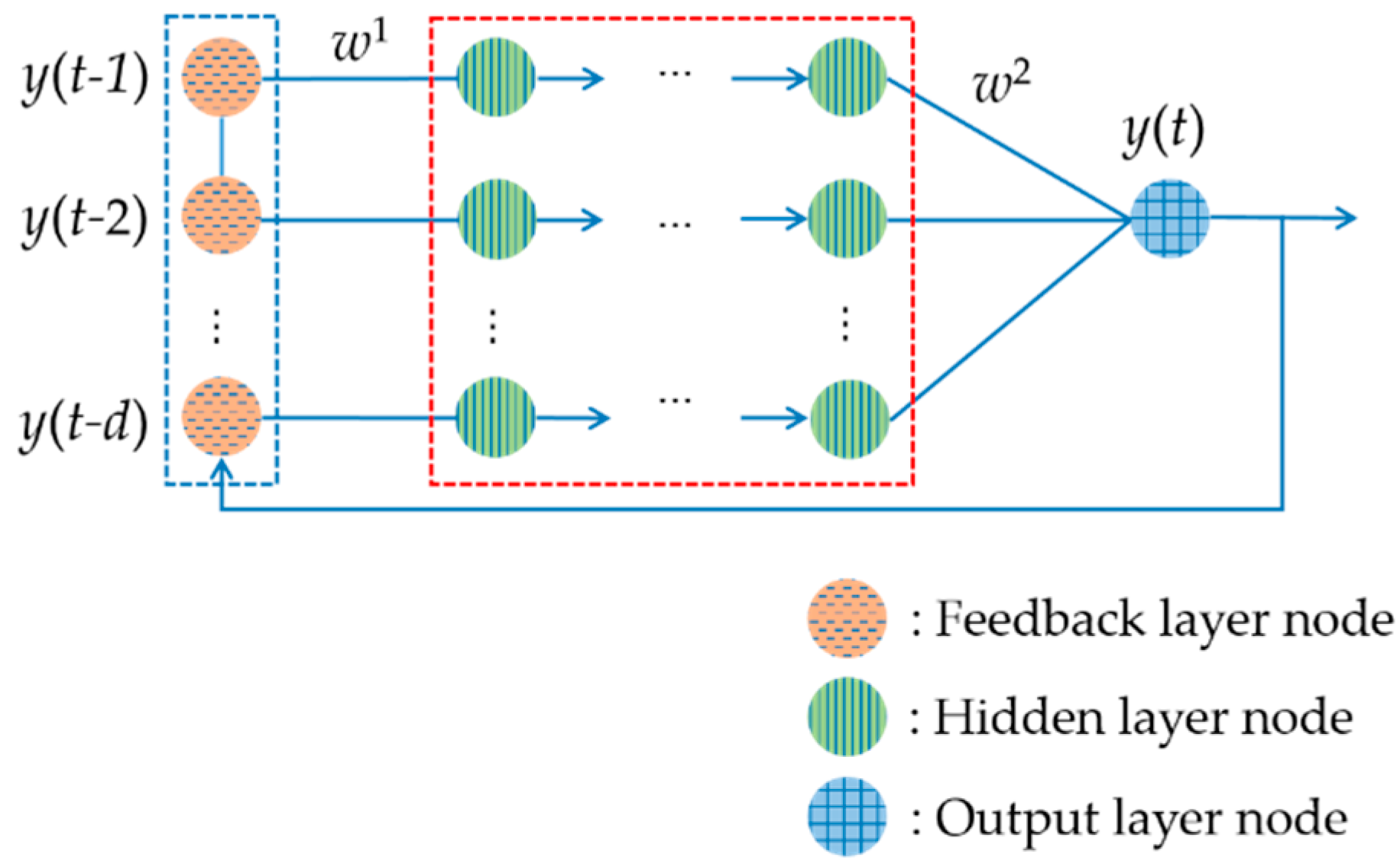

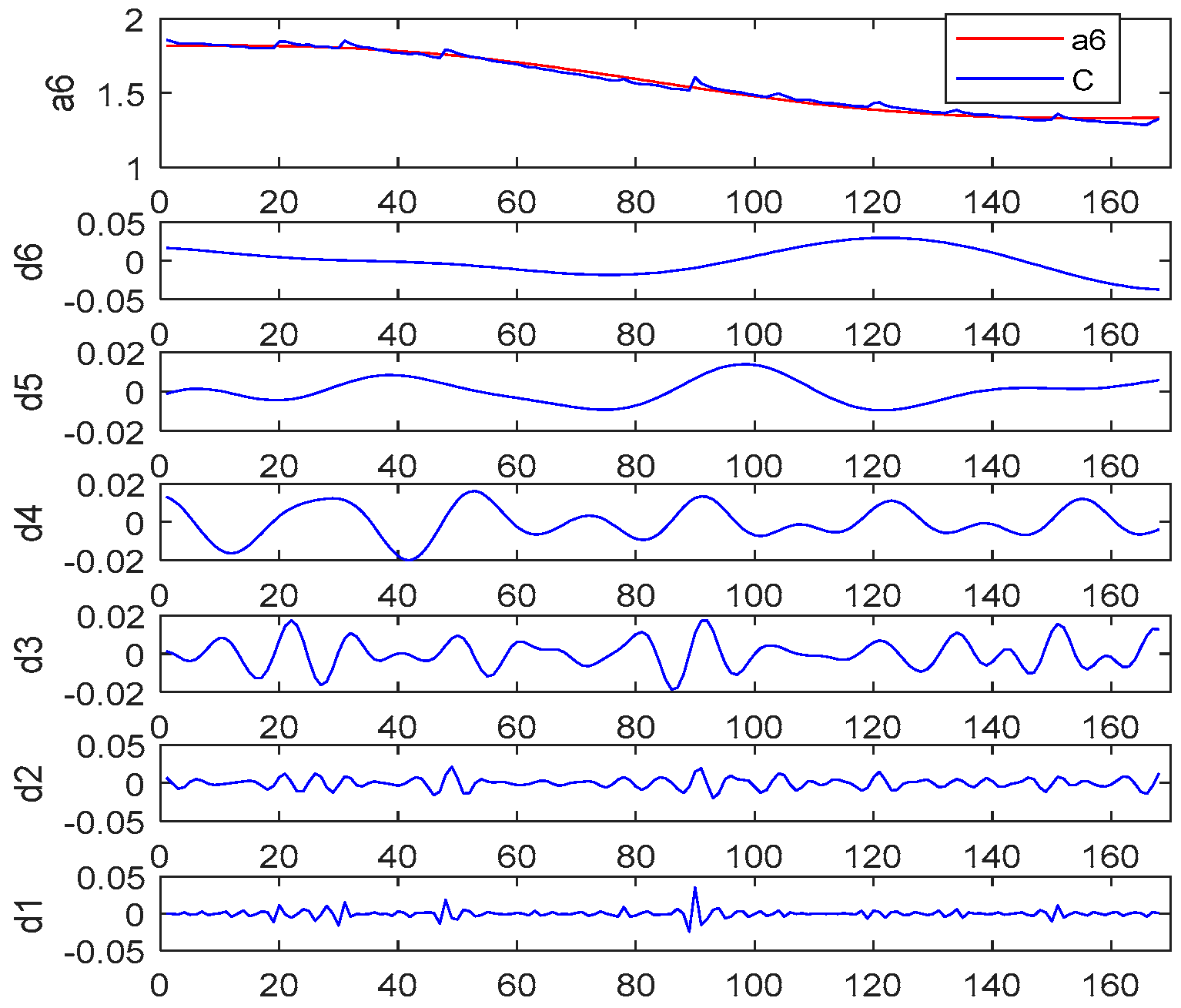

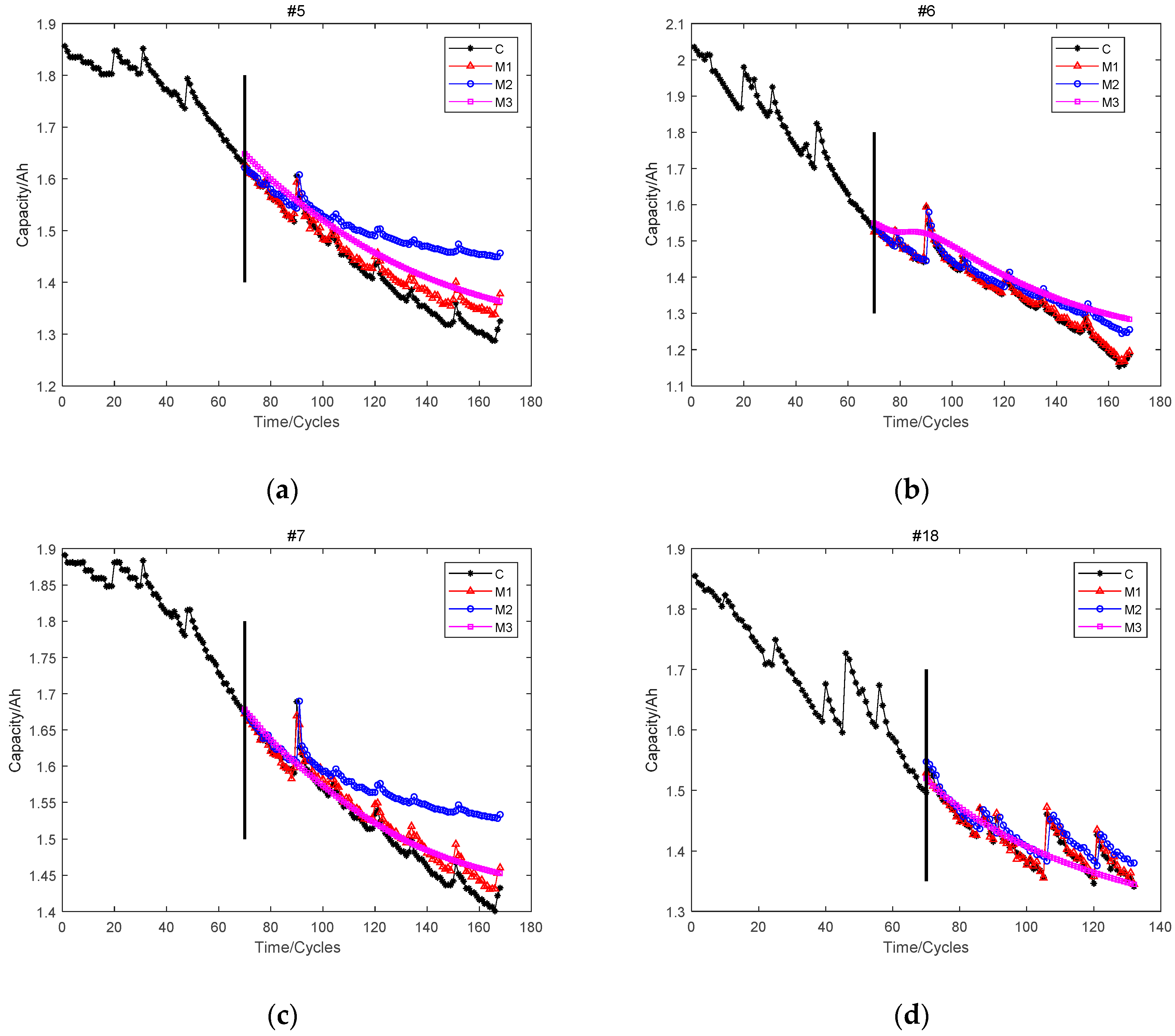
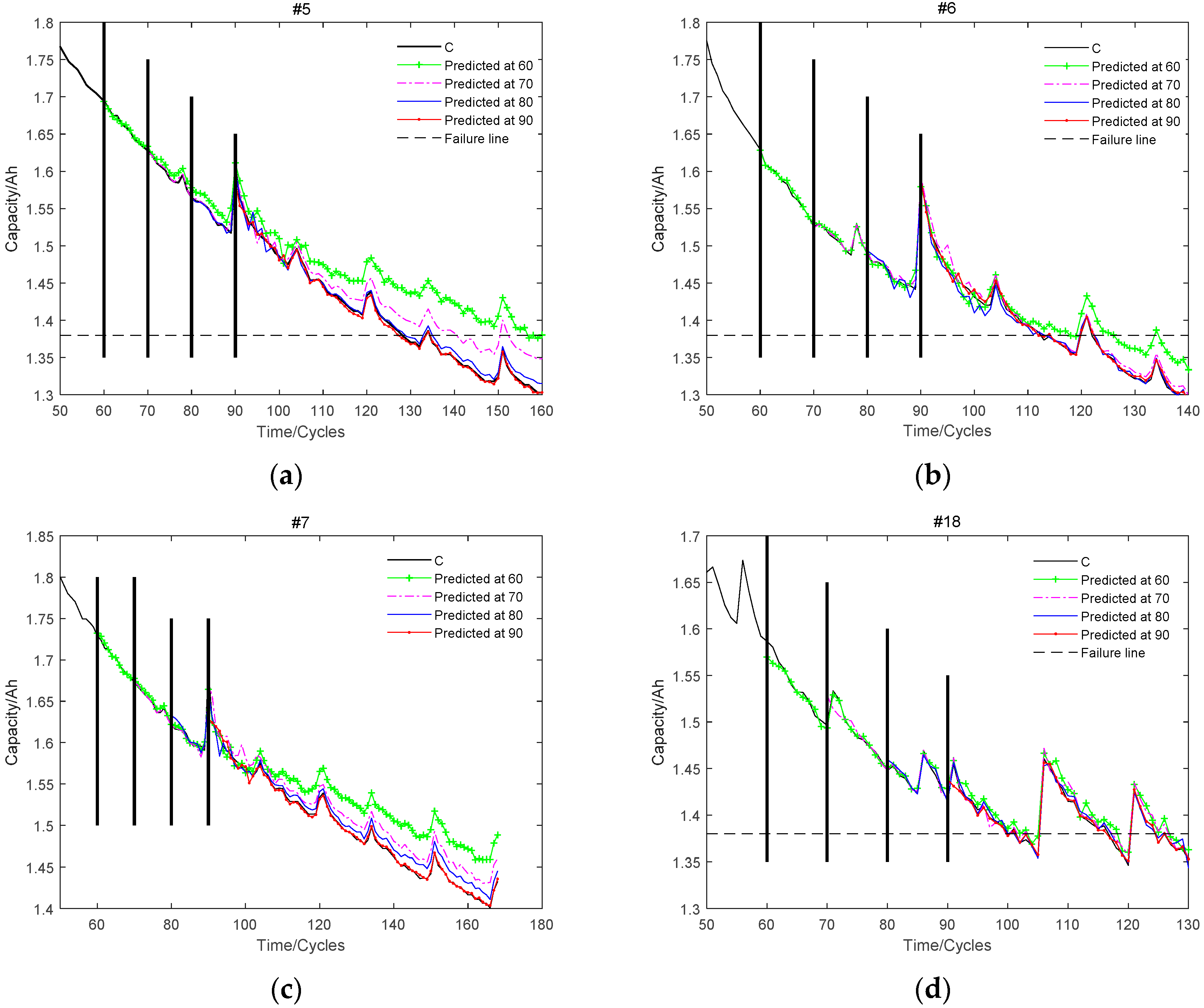
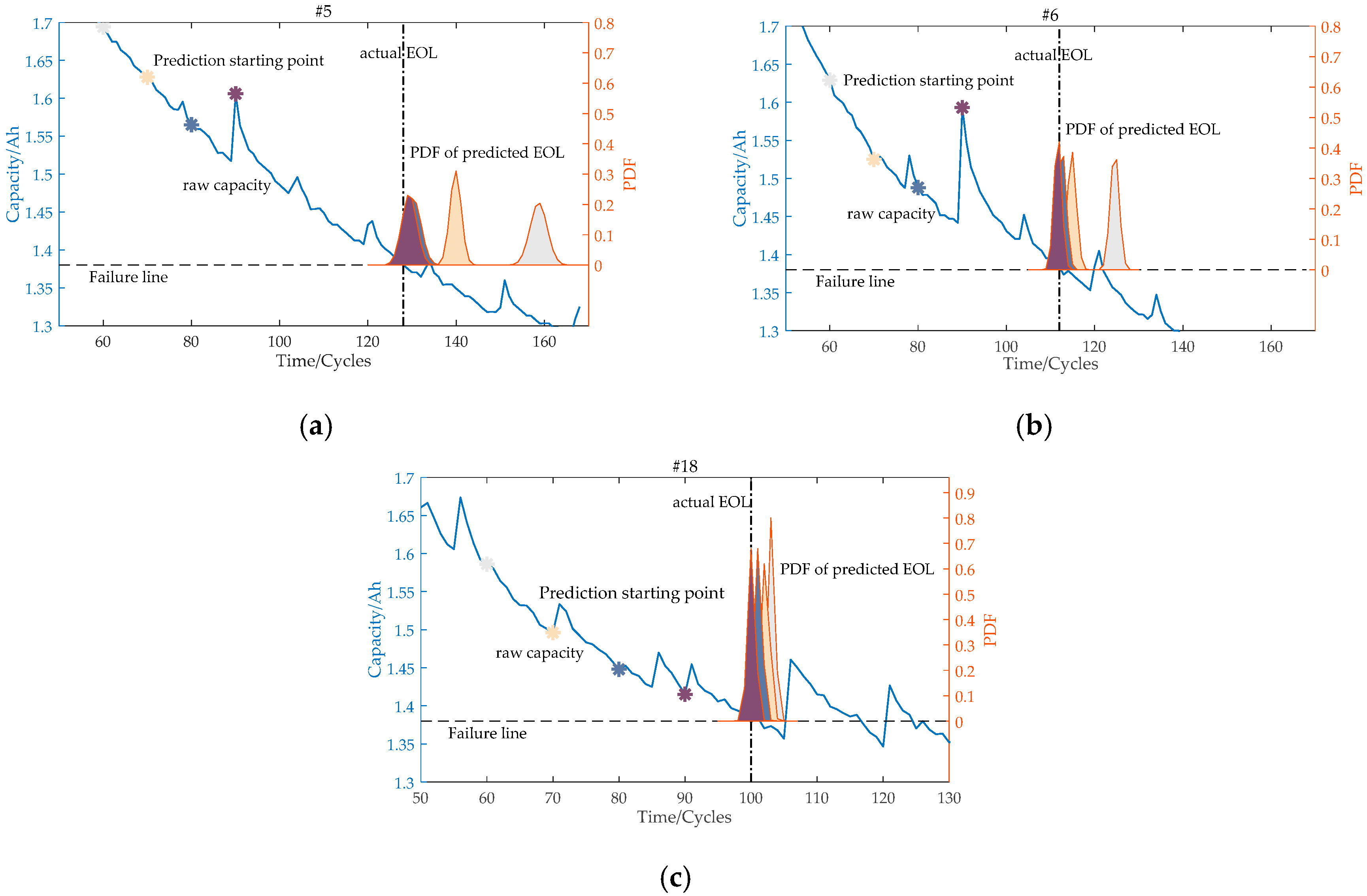
| Model | Model Description |
|---|---|
| M1 | WDT combine with NARNN |
| M2 | NARNN without using WDT |
| M3 | WDT combine with BPNN |
| Evaluate Criteria | Model | #5 | #6 | #7 | #18 |
|---|---|---|---|---|---|
| RMSE | M1 | 0.0270 | 0.0087 | 0.0175 | 0.0064 |
| M2 | 0.0949 | 0.0436 | 0.0678 | 0.0260 | |
| M3 | 0.0500 | 0.0616 | 0.0234 | 0.0253 | |
| R2 | M1 | 0.9226 | 0.9933 | 0.9460 | 0.9751 |
| M2 | 0.4151 | 0.8457 | 0.4611 | 0.6494 | |
| M3 | 0.7745 | 0.7298 | 0.9035 | 0.6091 |
| Battery | Prediction starting point | Predicted RUL | RUL AE |
|---|---|---|---|
| #5 | 60 | 96 | 28 |
| 70 | 70 | 12 | |
| 80 | 48 | 0 | |
| 90 | 37 | 1 | |
| #6 | 60 | 57 | 5 |
| 70 | 42 | 0 | |
| 80 | 33 | 1 | |
| 90 | 22 | 0 | |
| #18 | 60 | 42 | 2 |
| 70 | 30 | 0 | |
| 80 | 20 | 0 | |
| 90 | 10 | 0 |
| Battery | Method | Average RUL AE | Average |
|---|---|---|---|
| #5 | M1 | 10.3 | - |
| M2 | 14 | 34.2% | |
| M3 | 12 | 21.1% | |
| M-LG | 16.3 | 14.3% | |
| #6 | M1 | 1.5 | - |
| M2 | 17.8 | 37.8% | |
| M3 | 12 | 34.6% | |
| M-LG | 22.3 | 54.9% | |
| #18 | M1 | 0.5 | - |
| M2 | 6.5 | 35.6% | |
| M3 | 14.8 | 50% | |
| M-LG | 6 | 25.8% |
© 2019 by the authors. Licensee MDPI, Basel, Switzerland. This article is an open access article distributed under the terms and conditions of the Creative Commons Attribution (CC BY) license (http://creativecommons.org/licenses/by/4.0/).
Share and Cite
Pang, X.; Huang, R.; Wen, J.; Shi, Y.; Jia, J.; Zeng, J. A Lithium-ion Battery RUL Prediction Method Considering the Capacity Regeneration Phenomenon. Energies 2019, 12, 2247. https://doi.org/10.3390/en12122247
Pang X, Huang R, Wen J, Shi Y, Jia J, Zeng J. A Lithium-ion Battery RUL Prediction Method Considering the Capacity Regeneration Phenomenon. Energies. 2019; 12(12):2247. https://doi.org/10.3390/en12122247
Chicago/Turabian StylePang, Xiaoqiong, Rui Huang, Jie Wen, Yuanhao Shi, Jianfang Jia, and Jianchao Zeng. 2019. "A Lithium-ion Battery RUL Prediction Method Considering the Capacity Regeneration Phenomenon" Energies 12, no. 12: 2247. https://doi.org/10.3390/en12122247
APA StylePang, X., Huang, R., Wen, J., Shi, Y., Jia, J., & Zeng, J. (2019). A Lithium-ion Battery RUL Prediction Method Considering the Capacity Regeneration Phenomenon. Energies, 12(12), 2247. https://doi.org/10.3390/en12122247





